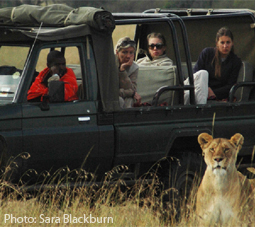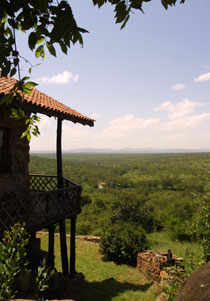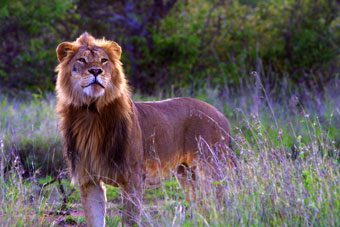| |
|
| |
WILDLIFE AS A FINANCIAL RESOURCE
Unless livestock
owners gain some economic benefit from lions there is still a great
likelihood that they will soon disappear outside protected parks. Protected areas and ecotourism will always be central to conservation. Tourism is a great source of income for Kenya, with
big cats being a major lure for visitors. |
It was estimated
that a male lion in Amboseli National Park is worth US $128,750
a year in tourist income. If landowners and communities were
to receive a proportion of these vast earnings, they would
have a strong incentive to conserve lions, and the greater
ecosystem that supports them.
Most protected areas are not big enough to ensure the long-term
survival of viable populations of lions, which need huge ranges
and hunting territories. Only a few National Parks in Africa
are big enough to supply these, and most are too widely separated to prevent inbreeding,
causing many ‘protected’ lion populations to suffer
genetic problems such as increased vulnerability to disease. |
|

|

|
|
Because of this, it is vital that lions are protected outside these parks, and many livestock ranches supplement their incomes by operating tourist lodges and protecting their wildlife.
Pastoralists on the communal lands, however, have not been able to establish tourism as a potential alternative to their dependence on livestock, and wildlife is scarce in many areas.
LWL helps introduce these communities to the potential income to be gained from wildlife-based ecotourism, explaining that tourism requires wildlife, especially predators, and that maintaining healthy populations of grazers like wildebeest and zebra is also likely to decrease attacks on their livestock. |
It has been suggested that trophy hunting may be another way to derive economic value from wildlife, giving people an incentive to coexist with wildlife as a lucrative resource, rather than eradicating it.
Many conservationists believe that the revenue from wealthy hunters, who are willing to pay very large sums to shoot an old male, could potentially be used for lion conservation, compensating for livestock losses and reducing the overall number of lions that are killed indiscriminately in retribution for cattle losses. |
|

|
However, Kenya has far too few lions and most other species, for hunting to be justifiable here. In countries such as Tanzania, Zambia and Mozambique, however, hunting has great conservation potential that has yet to be realized. |
|
|
| |
All images are copyright
protected and may not be used without permission. Web design and all photography,
unless otherwise stated is by Amy Howard. www.amyhoward.co.uk |
|
|

